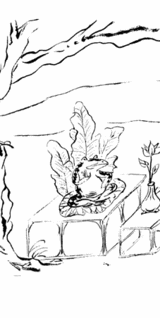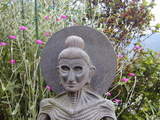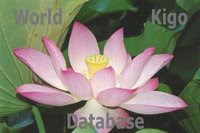:::::::::::::::::::::::::::::::::::::::::::::::::::::::::::::::::::::::::::::::::::::::::::::::::::::
Frog (kawazu, kaeru)
***** Location: Japan, other regions
***** Season: Spring, Summer, Autumn (see below)
***** Category: Animal
*****************************
Explanation
There are many types of frogs and toads on our planet. And for haiku friends, the frog lives on a special podest because of Basho and his "old pond" haiku.

Let us look at some frogs the way they are used as kigo in various seasons.
:::::::::::::::::::::::::::::::::::::::::::::::::::::::::::::::::::::::::::::::::::::::::::::::::::::
.. .. .. ALL SPRING
frog, kaeru, kawazu 蛙
This is a very general term and does not include the various species mentioned below.
red frog, akagaeru 赤蛙
Lord Frog, tonosama gaeru 殿様蛙
frog in the ground, tsuchi gaeru 土蛙
first voice of the frog, hatsu kawazu 初蛙
frog voice afar, toogaeru 遠蛙
frog voice during the day, hiru gaeru 昼蛙
frog voice in the evening, yuu-gaeru 夕蛙
frog in the mountains, yamagaeru 山蛙
frog in rice plantariums, nawajiro kawazu 苗代蛙
frog in mud, dorokawazu 泥蛙
frog concert, kawazu gassen 蛙合戦
Frogs tend to come out of their winter hiding from the earth at the end of Feburary. They enjoy to live in the wet ricefields during spring and summer.
My home in Okayama is surrounded by terraced rice fields and the annual frog concert season is quite something!
There is also a proverb about the frogs borrowing human eyes, expressing the drowsiness in late spring. This is also a kigo:
kawazu no me karidoki 蛙の目借時
time of borrowed eyes, mekari doki 目借時
Karl the Froggie at GokuRakuAn, Gabi Greve

the BIG picture -
a frog is a frog
is a frog
Can you detect him? If not, check in here :
. My Karl in Spring 2012 .
.................................................................................
kigo for late spring
otamajakushi, o-tama-jakushi お玉杓子 (おたまじゃくし)
tadpole, tadpoles. Kaulquappe
kawazu no ko 蛙の子(かわずのこ)"child of the frog", baby frog
..... juzuko 数珠子(じゅずこ)"rosary children",
..... kato 蝌蚪(かと)
..... kaerugo かえるご
kaeru umaru 蛙生る(かえるうまる)frogs are born
:::::::::::::::::::::::::::::::::::::::::::::::::::::::::::::::::::::::::::::::::::::::::::::::::::::
.. .. .. ALL SUMMER
green frog, aogaeru 青蛙 Species Hyla
tree frog, rain frog, amagaeru 雨蛙
summer frog, natsugaeru 夏蛙
river frog, kajika 河鹿, kajikagaeru 河鹿蛙 Polypedates buergeri
river frog song (lit. flute), kajijabue 河鹿笛
..... Kajika is noted for its attractive voice when singing in the river.
. kajika 鰍 (かじか) 杜父魚 bullhead fish, Okoze .
.................................................................................
toad, bullfrog, hikigaeru 蟇蛙 Bufo vulgaris
... also hiki 蟾 or gama 蝦蟇
but
kigo for mid-spring
hiki ana o izu 蟇穴を出づ (ひきあなをいづ)
toad coming out of its hole
..... hiki ana o deru 蟇穴を出る(ひきあなをでる)
..... hiki izu 蟇出づ(ひきいづ)
月の句を吐いてへらさん蟇の腹
tsuki no ku o haite herasan hiki no hara
let me spit out
poems to relieve the belly
of this toad
Buson refers to an old Chinese legend, where a bullfrog lives on the moon. When the frog has eaten too much, its belly begins to swell.
And tonight, Buson has eaten too much while watching the ful moon . . .
. Yosa Buson 与謝蕪村 in Edo .

source : mushroom frog art
The frog (or toad) in the moon
toad as a symbol of yin, and so many Chinese tales refer to the toad whose face is visible at the full moon.
- reference -
:::::::::::::::::::::::::::::::::::::::::::::::::::::::::::::::::::::::::::::::::::::::::::::::::::::
.. .. .. MID-AUTUMN
frogs in autumn, aki no kawazu 秋の蛙 (あきのかわず)
frogs start to hibernate, kawazu ana ni iru 蛙穴に入る(かわずあなにいる)
:::::::::::::::::::::::::::::::::::::::::::::::::::::::::::::::::::::::::::::::::::::::::::::::::::::
.. .. .. Late Winter
Tago frog, tagogaeru たご蛙 (たごがえる)
A variety of red frogs, about 4 cm ling, that live in Honshu and more south. Even in winter it calls for its mate, sounding guuguuguu.
:::::::::::::::::::::::::::::::::::::::::::::::::::::::::::::::::::::::::::::::::::::::::::::::::::::::::::::::
quote
Types of frogs
"So what's the difference between the two words for frog: kaeru and kawazu?" The common answer is that kawazu is the "old word" that got replaced by the "new word" kaeru, but this is a misconception. It's really just another case of semantic overlap combined with poetic versus everyday register.
It's true that there are no kaeru as such in the Manyōshū -- all the frogs that appear as frogs are kawazu (/kahadu/, at the time). But this is not because the word kaeru had yet to be invented.
snip
One reason was that kaeru was a general word, while the original meaning of kawazu seems to have specifically been "kajika frog". The kajika frog is so called because it lives in rivers (ka(wa)) and has a haunting call like a deer (shika), making it ideal for use in poetry. Virtually all of the Manyōshū poems that include a kawazu specifically refer to its call.
Maybe for this reason, kawazu also seems to have been the preferred word in poetry for frogs in general. There is a word for this in Japanese aesthetics: kago (歌語, "poetry word"). Another good example is references to cranes: the word tsuru is plenty old (some say it came over direct from the continent), but most early poems used the word tazu (たづ) instead. That was the kago.
So maybe kawazu originally meant "kajika frog" in particular, but it didn't take long before it just meant "frog [+poetic]" in general. Meanwhile, kaeru was a perfectly healthy synonym meaning "frog [-poetic]".
Eventually, poetry would be modernized in such a way that people felt quite comfortable using the word kaeru, which left kawazu stranded, gradually shifting towards meaning simply "frog [+archaic]". Kaeru, on the other hand, became simply "frog" (unmarked).
Kawazu would probably have been forgotten by all but the specialists by now (much like tazu) if it weren't for one thing: the Dark Side of the Moon of traditional Japanese poetry, that one haikai by Bashō that everyone knows...
source : no-sword.jp/blog
************************************
Worldwide use
Kenya
The bull frog is a rainy season kigo.
It is extraordinarily hard to catch sight of it -- while its voice is an unmistakable sign of the rainy season!
Isabelle Prondzynski
:::::::::::::::::::::::::::::::::::::::::::::::::::::::::::::::::::::::::::::::::::::::::::::::::::::
North America
Spring peeper
kigo for all spring
The Spring Peeper (Pseudacris crucifer, synonym Hyla crucifer) is a small tree frog widespread throughout the eastern USA.
More in the WIKIPEDIA !
new peepers
singing their song of
heart's desire
spring chorus
peepers sing love songs
at sunset
© bob
.................................................................................

source : Native American Design
little frog...
your pad is but a dot
in this old pond
opie, Texas
**********************************
Things found on the way
The famous scroll of the frolicking animals.
Choojuu-giga scrolls (choju giga) 鳥獣戯画

http://www.kokingumi.com/ChojuGiga/66.html
See comment Nr. 2 below.
...........................................

furuike ya Daruma tobikomu mizu no oto
this old pond -
the sound of water
as my Daruma jumps in
© Gabi Greve ..... Look at more !
:::::::::::::::::::::::::::::::::::::::::::::::::::::::::::::::::::::::::::::::::::::::::::::::::::::
"If by sitting in mediation,
one becomes Buddha..."
坐禅して人が仏になるならば

. Sengai Gibon (1751–1837) 仙厓義梵 .
:::::::::::::::::::::::::::::::::::::::::::::::::::::::::::::::::::::::::::::::::::::::::::::::::::::::
Brother Bruno and the frog
When Brother Bruno was at prayer he was disturbed by the croaking of a bull frog. His attempts to disregard the sound were unsuccessful so he shouted,
“Quiet! I’m at my prayers”.
Now Bruno was a saint so he was instantly obeyed. But now another sound intruded – an inner voice – that said, “Maybe God is as pleased with the croaking of that frog as with the chanting of your psalms.
“What can please the ears of God in the croak of a frog?” was Bruno’s rejoinder.
But the voice refused to give up:
“ Why would you think God invented the sound?” Bruno decided to find out. He leaned out of his window and ordered the frog to sing. The croaking filled the air to the ludicrous accompaniment of all the frogs in the vicinity.
As Bruno listened their voices ceased to jar.
If he stopped resisting them, they actually enriched the silence of the night. With that discovery his heart became harmonious with the universe and, for the first time in his life he understood what it means to pray.
Joseph Stoutzenberger - Celebrating Sacraments
source : books.google.co.jp
:::::::::::::::::::::::::::::::::::::::::::::::::::::::::::::::::::::::::::::::::::::::::::::::::::::
akagaeru uri 赤蛙売り selling red frogs
yanagi mushi uri 柳虫売り

source : www.tpa-kitatama.jp/museum
akahikigan 赤蛙丸 "red frog medicine", for children
It helped to quiet down nervous children.

For children, there are also some "mushi" connected with illness like the
san-shi no mushi 三尸の虫 -
kan no mushi 疳の虫 / 癇 insect of nervousness, short-temperedness
nakimushi 泣き虫 insect of crying too much
hara no mushi 腹の虫 insect causing diarrhea
. sanshi no mushi 三尸の虫 The Three Worms .
The red frogs were also eaten in Edo and many parts of the countryside..
. Doing Business in Edo .
*****************************
HAIKU
Furu ike ya kawazu tobikomu mizu no oto
古池や蛙飛び込む水の音
Old pond — frogs jumped in — sound of water
Translated by Lafcadio Hearn
To Japanese of sensitivity, frogs are dear little creatures, and Westerners may at least appreciate this animal’s energy and immediacy. Plop!
30 translations of this famous haiku online are here,
with a Commentary by Robert Aitken
http://www.bopsecrets.org/gateway/passages/basho-frog.htm
Sound of Water
a haiku discussion !!!
xxxxxxxxxxxxxxxxxxxxxxxxxxxxxxxxxxxxxxxxxxxxxxxx

little green frog -
even your voice
the voice of Buddha
Click on the photo to see the whole story
by Gabi Greve
.. .. .. .. .. ..
a frog farting -
this too is the
voice of Buddha
a frog farting -
this too is the
voice of God
More about the Voice of Buddha and Frog
:::::::::::::::::::::::::::::::::::::::::::::::::::::::::::::::::::::::::::::::::::::::::::::::::::::

手をついて歌申あぐる蛙かな
te o tsuite uta mooshiageru kawazu kana
his hands bend down
offering a song -
this frog
or
with a formal bow
he offers a song -
this frog
Yamazaki Sookan 山崎宗鑑 Sokan
(1465 - 1553)
(The Japanese has the kireji KANA at the end of line 3.)
:::::::::::::::::::::::::::::::::::::::::::::::::::::::::::::::::::::::::::::::::::::::::::::::::::::
- - - - - Yosa Buson - and the kawazu, one frog or more frogs . . .
古池の蛙老いゆく落葉かな
furuike no kawazu oiyuku ochiba kana
in the old pond
the frog is getting old
among the falling leaves . . .
The cut marker KANA is at the end of line 3.
春雨や蛙の腹はまだぬれず
harusame ya kawazu no hara wa mada nurezu
spring rain -
the belly of this frog
is not yet wet
朧月 蛙に濁る水やそら
oborozuki kawazu ni nigoru mizu ya sora
misty moon of spring -
water and sky are muddied
by the frogs
泳ぐ時よるべなきさまの蛙かな
oyogu toki yorube naki sama no kawazu kana
when it swims
its has such an unsteady figure
this frog . . .
The cut marker KANA is at the end of line 3.
たたずめば 遠くも聞ゆ蛙かな
tatazumeba tooku mo kikoyu kawazu kana
when I stand still
in the far distance I can hear
the frogs . . .
The cut marker KANA is at the end of line 3.
- - - - - and some personifications
日は日くれよ夜は夜明けよと鳴く蛙
hi wa hi kure yo - yo wa yoake yo to - naku kawazu
during the day "may sunset come"
during the night "may daybreak come"
call the frogs
風なくて雨降れとよぶ蛙かな
kaze nakute ame fure to yobu kawazu kana
"with no wind
let there be some rain !"
call the frogs . . .
During a summer drought, but please no typhoon . . .
The cut marker KANA is at the end of line 3.
. WKD : Yosa Buson 与謝蕪村 in Edo .
:::::::::::::::::::::::::::::::::::::::::::::::::::::::::::::::::::::::::::::::::::::::::::::::::::::
Carpenter frogs
hammering nails out of synch:
"cu-tuck, cu-tuck, cu-tuck..."
Darkened ditch –
the harsh “rraak, rraak, rraak”
of a squirrel tree frog
Pinewood tree frogs
tapping out a telegraph:
"dik-dik-dikadik..."
Zhanna P. Rader
Read more of Zhanna's frog haiku here:
http://groups.yahoo.com/group/happyhaiku/message/1621
xxxxxxxxxxxxxxxxxxxxxxxxxxxxx
frog jumps
reflections
ruined
a tiny frog leaps
out of the moon
creates ripples
Marella Vinodh
xxxxxxxxxxxxxxxxxxxxxxxxxxxx
I remember the very first time that a Japanese friend offered to drive me from the local town to the next one. Sitting in a car offers a great opportunity to say "Stop!" and have a look -- in my case, at a rice field with a young and growing crop. And a green frog on top of one of the blades.
An unforgettable memory.
out of the car --
growing rice field holds a
tiny green frog
Isabelle Prondzynski
xxxxxxxxxxxxxxxxxxxxxxxxxxxxx
marine gallery
army outnumbered
by the navy
M. Shanna Moore, Hawaii
xxxxxxxxxxxxxxxxxxxxxxxxxxxxx
a big splash
and down he went
the prince
© Geert Verbeke
http://users.skynet.be/geert.verbeke.bowls
:::::::::::::::::::::::::::::::::::::::::::::::::::::::::::::::::::::::::::::::::::::::::::::::::::::
> yasegaeru makeru na Issa koko ni ari
> skinny frog
> don't give up the fight
> Issa is here!
Remarks from Larry Bole : Haiku Information Board
I wonder if thinking of this as a frog "sumo" match, with two frogs facing each other, doesn't give the wrong impression. I think I've seen this activity in some nature film at some time or other, so I have more of an impression of a number of male frogs fighting for position in the process of attempting to mount a female frog.
According to David G. Lanoue, "In his diary, Issa explains, 'I stooped to watch a frog scuffle on the 20th day of Fourth Month.' "
http://www.worldhaikureview.org/3-1/haikuined_dl.shtml
It's a shame that more translators don't include contextual information like this with their translations. I wonder if Issa included anything else in his diary about the writing of this haiku.
Both Makoto Ueda and Haruo Shirane mention the militaristic phrasing found in this haiku.
In his book "Dew on the Grass," Ueda writes:
Issa wrote the frog poem after seeing several frogs fighting for a lone female. The hokku has since become well known for its expression of sympathy toward the weak, but we should also take note of the self-confidence implied in it. Although he himself is a faltering old man,
he is still strong enough to help a frog. "Issa is here," which mimicks the self-announcement of a samurai on the battlefield, adds a touch of humor. [end of comment]
And Haruo Shirane, in his book "Early Modern Japanese Literature: An Anthology 1600-1900," writes:
"Don't give up!" ('makeru na Issa kore ni ari') is a military phrase used by a commander to urge on his troops. [end of comment]
I wonder, when a Japanese person hears this haiku, if they are struck by the military nature of the expression.
Even after over 200 years of relative peace in Japan, a military-style phrase still comes tripping off of Issa's tongue!
I think a spirit of nationalism must have been in the air. Issa certainly felt it when he wrote about geese now being "geese of Japan."
kyoo kara wa Nihon no kari zo raku ni neyo
From today
You're Japan's geese, wild ones,
Rest then in peace!
Issa, trans. Lewis Mackenzie
I wonder even if the "black ships" hadn't appeared when they did, if there still wouldn't have been a "Meiji restoration" at some point, and the renewed militarism which followed.
Larry Bole, February 2008
:::::::::::::::::::::::::::::::::::::::::::::::::::::::::::::::::::::::::::::::::::::::::::::::::::::
Speaking of Frogs
Haibun by Larry Bole, February 2008
Even though it's still winter here in New York City, spring is in the air, or just around the corner, as is said.
So I'm walking down the street in my neighborhood, and suddenly I hear a frog croaking! A frog in this mostly cement-covered neighborhood, with no appreciable body of water nearby except for a few stray puddles left over from last night's sleet shower? A frog in the midst of large apartment buildings crowded up against small, huddled groups of attached houses which have been split up inside into rental apartments, legally or illegally?
Well, some of those attached houses still have pocket-sized gardens out in front which haven't yet been cemented over. So I began my search. The frog croaking seemed to be coming from a small patch of dirt, about five feet by five feet, which was crowded with white plaster rabbits, ducks, and several sets of cherubic children. In the growing season there will barely be room for plants!
Looking and looking I finally spotted it: an accurately painted green ceramic frog sitting on a green ceramic lily pad, afloat on the garden dirt.
A little hole in the frog's open mouth indicated the presence of some sort of electronic soundmaking device hidden inside. Ah, the wonders of modern technology!
spring is in the air!
even the ceramic frog
goes "ribbit! ribbit!"
:::::::::::::::::::::::::::::::::::::::::::::::::::::::::::::::::::::::::::::::::::::::::::::::::::

Haiga by Emile Molhuysen, February 2008
:::::::::::::::::::::::::::::::::::::::::::::::::::::::::::::::::::::::::::::::::::::::::::::::::::
watching the seeds sprout-
guarding a pail of tadpoles
like a mother frog
Lisette Root
Happy Haiku December 2010
:::::::::::::::::::::::::::::::::::::::::::::::::::::::::::::::::::::::::::::::::::::::::::::::::::::
a tiny frog
dancing the jig -
facebook encounters
Look at him here
. Gabi Greve .
July 2012
*****************************
Related words
2008, the Year of the Frog
***** Leap day, leap year 2008
. ANIMALS in all SEASONS - SAIJIKI
The word for frog is pronounced "kaeru."
It is a pun with the word "return home."
Therefore travelers carry a small frog amulet with the intent of returning safely to their family.
. Kaeru omamori カエルお守り 蛙 Frog amulets .
:::::::::::::::::::::::::::::::::::::::::::::::::::::::::::::::::::::::::::::::::::::::::::::::::::::

"Frog Sumo"
Ogata Gekkō (1859-1920)
:::::::::::::::::::::::::::::::::::::::::::::::::::::::::::::::::::::::::::::::::::::::::::::::::::::
[ . BACK to Worldkigo TOP . ]
:::::::::::::::::::::::::::::::::::::::::::::::::::::::::::::::::::::::::::::::::::::::::::::::::::::


























